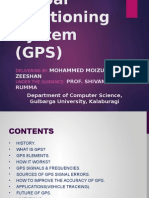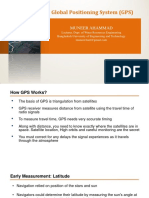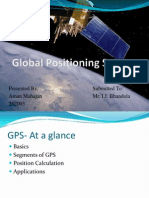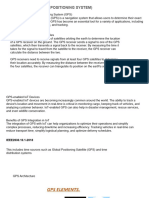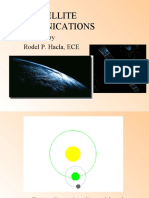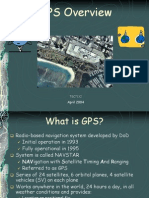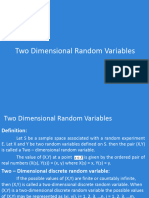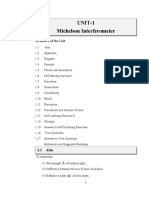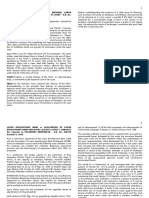Global Positioning System
Global Positioning System
Uploaded by
Aftab Khan0 ratings0% found this document useful (0 votes)
35 views22 pagesThe Global Positioning System is a space-based satellite navigation system that provides location and time information to GPS receivers anywhere on Earth. It became fully operational in 1995 with 24 satellites in six orbital planes. GPS uses trilateration to calculate a user's position by measuring distances to four or more satellites. It provides location, velocity, and precise time data to users with an accuracy of a few meters.
Original Description:
Original Title
GPS
Copyright
© © All Rights Reserved
Available Formats
PPTX, PDF, TXT or read online from Scribd
Share this document
Did you find this document useful?
Is this content inappropriate?
Report this DocumentThe Global Positioning System is a space-based satellite navigation system that provides location and time information to GPS receivers anywhere on Earth. It became fully operational in 1995 with 24 satellites in six orbital planes. GPS uses trilateration to calculate a user's position by measuring distances to four or more satellites. It provides location, velocity, and precise time data to users with an accuracy of a few meters.
Copyright:
© All Rights Reserved
Available Formats
Download as PPTX, PDF, TXT or read online from Scribd
Download as pptx, pdf, or txt
0 ratings0% found this document useful (0 votes)
35 views22 pagesGlobal Positioning System
Global Positioning System
Uploaded by
Aftab KhanThe Global Positioning System is a space-based satellite navigation system that provides location and time information to GPS receivers anywhere on Earth. It became fully operational in 1995 with 24 satellites in six orbital planes. GPS uses trilateration to calculate a user's position by measuring distances to four or more satellites. It provides location, velocity, and precise time data to users with an accuracy of a few meters.
Copyright:
© All Rights Reserved
Available Formats
Download as PPTX, PDF, TXT or read online from Scribd
Download as pptx, pdf, or txt
You are on page 1of 22
Global Positioning System
Space-based satellite navigation system used to locate the
place
Project was developed in 1973 by U.S. Department of Defense
It became fully operational in 1995
There are different GPS systems
NAVSTAR - US
GLONASS - Russia
Galileo - EU
BeiDou - China.
QZSS - Japan
IRNSS – India
(Indian Regional Navigation Satellite System
IRNSS-1A,1B,…… )
SPACE SEGMENT-
GPS satellites - 24 satellites
GPS orbits at an altitude of 20,200 km and
Period of revolution -12 hours
Powered by solar cells & nickel cadmium batteries
The satellites continuously orient themselves to point their
solar panels toward the sun and their antenna towards the
earth. Orbital planes are inclined at 55˚ with respect to equator.
Orbits are separated by 60˚
At least 5 to 8 satellites are always within line of sight from any
location on the planet
Life time of satellite- 7.5 years and replacements are constantly
being built and launched into orbit
CONTROL SEGMENT
Master Control System Monitor Stations and Ground Antennas
• MASTER CONTROL STATION located at Falcon Air Force Base
in Colorado Springs, The control segment comprises a
master control station and five monitor stations outfitted
with atomic clocks that are spread around the globe.
• Checks the exact altitude, position, speed, and overall health
of the orbiting satellites. The control segment ensures that
the GPS satellite orbits and clocks remain within acceptable
limits.
• A station can track up to 11 satellites at a time
• They measure the distances of the overhead satellites every
1.5 seconds and send the corrected data to Master control.
• The five monitor stations monitor the GPS satellites and then
send information to the master control station where
abnormalities are revised and sent back to the GPS satellites
through ground antennas.
• Schriever Air Force Base in Colorado
• Cape Canaveral
• Florida
• Hawaii
• Ascension Island in the Atlantic Ocean
• Diego Garcia Atoll in the Indian Ocean
• Kwajalein Island in the South Pacific Ocean.
Atomic clock
• An atomic clock principle: When electromagnetic radiation
interacts with the excited states of certain atoms, there is a
hyperfine transition in the microwave region, or an
electron transition in the optical or ultraviolet region of the
emission spectrum of an atom is used as a frequency
standard
55Cs - 137 9192631770 Hz
37Rb - 87
User Segment
GPS receiver, receives the signals from the GPS
satellites and determines
(1) how far away it is from each satellite and
(2) Latitude
(3) Longitude
(4) Altitude
(5) Velocity
• GPS receivers are generally composed of
• 1. an antenna tuned to the frequencies transmitted
by the satellites
• 2. receiver-processors
• 3. highly-stable clock (commonly a crystal
oscillator). They can also include a display for
showing location and speed information to the user.
A receiver is often described by its number of
channels (this signifies how many satellites it can
monitor simultaneously). As of recent, receivers
usually have between twelve and twenty channels.
• GPS receivers calculate distances to satellites as a function of
the amount of time it takes for satellites' signals to reach the
ground. A GPS Receiver is a L-band radio processor capable of
solving the navigation equations in order to determine the
user position, velocity and precise time (PVT), by processing
the signal broadcasted by GPS satellites
• The Global Positioning System carriers are in
the L band, centered at 1176.45 MHz (L5),
1227.60 MHz (L2), 1381.05 MHz (L3), and
1575.42 MHz (L1) frequencies. L band waves
are used for GPS units because they are able
to penetrate clouds, fog, rain, storms, and
vegetation
• C/A code or Coarse Acquisition Code(Each code consists of
1,023 chips and is sent at a rate of 1.023 megabits per
second. The code sequence repeats every millisecond).
• P-Code or Precise Code
OTHER components of receiver
• Receiving Antenna:
• LNA (Low Noise Amplifier):
• IF Amplifier:
• Analog to digital converter
• Microprocessor :
A microprocessor is a computer processor that incorporates the functions
of a central processing unit
• How GPS Determines a Position
The working of the Global positioning system is based on the
‘trilateration’ means measuring distance
Triangulation means measuring angle
The position is determined from the distance measurements to
satellites. Four satellites are used to determine the position of
the receiver on the earth. The target location is confirmed by
the 4th satellite. And three satellites are used to trace the
location place.
How Accurate GPS ?
Physical Obstructions
The measurements of arrival time can be skewed through
large masses such as buildings, mountains, trees, etc.
Atmospheric Effects
GPS devices mainly affected by solar storms, Ionospheric
delays
A major source of error in GPS arises from the fact that the
speed of the radio signals is constant only in a vacuum which
means that distance measurements may vary as the values of
the speed of signal vary in the atmosphere
GPS applications
• GPS receivers are used by soldiers, in aircrafts, F-16 fighters,
Navy ships, minesweeping
• GPS has become important for all military operations and
weapons systems.
• GPS is also used by car racers, hunters, bikers, and cross-
country skiers
• GPS is used by police, fire, emergency medical service
enabling the quickest possible response in death or life
situations.
You might also like
- Tiktok Growth PDFDocument9 pagesTiktok Growth PDFjulNo ratings yet
- Global Positioning SystemDocument44 pagesGlobal Positioning Systemmdmoiz121No ratings yet
- Original Standard - DIN 32876-1-198604Document6 pagesOriginal Standard - DIN 32876-1-198604TereNo ratings yet
- Science 20 Unit B 08Document133 pagesScience 20 Unit B 08api-207957230100% (1)
- Civils Design GiudeDocument53 pagesCivils Design GiudeShepherd Nhanga100% (4)
- By: Sir Umair Rasheed: The University of LahoreDocument41 pagesBy: Sir Umair Rasheed: The University of LahoreSuman AgarwalNo ratings yet
- Principle of Functioning of DGPS & ETSDocument64 pagesPrinciple of Functioning of DGPS & ETSseshukvs100% (1)
- Seminar On GPS: By, PruthwinDocument24 pagesSeminar On GPS: By, PruthwinPruthwinNo ratings yet
- Gps NotesDocument49 pagesGps Notesjags3002No ratings yet
- Global Positioning System: Introduction ToDocument58 pagesGlobal Positioning System: Introduction ToYasir Malik0% (1)
- CE-321 Gps - Slides - EtcDocument129 pagesCE-321 Gps - Slides - EtcShubham BansalNo ratings yet
- Chap 2 GPSDocument41 pagesChap 2 GPSLayani KatinNo ratings yet
- Global Positioning SysstemDocument40 pagesGlobal Positioning SysstemAnup MishraNo ratings yet
- Global Positioning System (GPS)Document21 pagesGlobal Positioning System (GPS)Rahul Sharma100% (1)
- Global Navigation Satellite SystemDocument21 pagesGlobal Navigation Satellite SystemMike MSBNo ratings yet
- GpsDocument22 pagesGpsSujan Singh100% (1)
- Introduction To Global Positioning SystemsDocument32 pagesIntroduction To Global Positioning SystemsMahamiNo ratings yet
- Global Positioning SystemsDocument34 pagesGlobal Positioning Systemsthupten tsundue100% (1)
- GPSDocument20 pagesGPSJanardanNo ratings yet
- GNSS and GPS - S Barman - 2020 - Anna's ArchiveDocument23 pagesGNSS and GPS - S Barman - 2020 - Anna's ArchivetrazadosferroviariosNo ratings yet
- GPSDocument149 pagesGPSVivek Gill100% (2)
- Chapter 5Document51 pagesChapter 5samueladdissu92No ratings yet
- Mod V Adv SurvDocument35 pagesMod V Adv SurvSouravNo ratings yet
- Global Positioning SystemDocument24 pagesGlobal Positioning Systemian jheferNo ratings yet
- GPS Triangulation ProcedureDocument43 pagesGPS Triangulation Procedurehim92No ratings yet
- Outline: Combining GPS & Cellular Network Measurements For PositioningDocument9 pagesOutline: Combining GPS & Cellular Network Measurements For PositioningMuhammad Niyas N SNo ratings yet
- Unit 2 - GNSSDocument33 pagesUnit 2 - GNSSThe SinghNo ratings yet
- Mod 5 SurveyingDocument281 pagesMod 5 SurveyingAa AaNo ratings yet
- Electronic Navigation: Lesson-6a: Satellite NavigationDocument159 pagesElectronic Navigation: Lesson-6a: Satellite NavigationErcan Yüksekyıldız0% (1)
- 17.GPS Borj EditDocument55 pages17.GPS Borj EditDaniel Viterbo RodriguezNo ratings yet
- Radio Aids Viva-1Document93 pagesRadio Aids Viva-1s malikNo ratings yet
- Lecture 4 - Introduction To Global Positioning SystemDocument40 pagesLecture 4 - Introduction To Global Positioning SystembuhlyunbarterNo ratings yet
- Global Positioning System (GPS) : A Operators Guide To Use GPS Effectively As A Survey ToolDocument25 pagesGlobal Positioning System (GPS) : A Operators Guide To Use GPS Effectively As A Survey ToolTheyen NaidooNo ratings yet
- Communications Equipment II (CM 417) - 4Document14 pagesCommunications Equipment II (CM 417) - 4Sara ElsilinyNo ratings yet
- Introduction Gps Presentation 1Document57 pagesIntroduction Gps Presentation 1ganeshNo ratings yet
- GIS - Lec 6 - GPSDocument16 pagesGIS - Lec 6 - GPSjahidNo ratings yet
- Global Positioning System (GPS) Global Positioning System (GPS)Document14 pagesGlobal Positioning System (GPS) Global Positioning System (GPS)Hamody NasryNo ratings yet
- Global Positioning SystemDocument20 pagesGlobal Positioning SystemJyoti Prakash PrustyNo ratings yet
- Space Segment:: GPS Working MechanismDocument4 pagesSpace Segment:: GPS Working MechanismSiddharthNo ratings yet
- By Sachin Hundekar (2bl04is039) Under The Guidance of Syeda SheemaDocument31 pagesBy Sachin Hundekar (2bl04is039) Under The Guidance of Syeda SheemaSachin HundekarNo ratings yet
- Orbits and Intro. For GPSDocument3 pagesOrbits and Intro. For GPSAboody AL-ghamdyNo ratings yet
- Global Positioning SystemDocument117 pagesGlobal Positioning SystemSaurabh SumanNo ratings yet
- Presented By: Submitted To: Aman Mahajan Mr. I.J. Bhandola 282003Document29 pagesPresented By: Submitted To: Aman Mahajan Mr. I.J. Bhandola 282003Aman MahajanNo ratings yet
- Avleen GPS 2Document27 pagesAvleen GPS 2saabi singhNo ratings yet
- Global Navigation Satellite System (GNSS) : Group ViiDocument16 pagesGlobal Navigation Satellite System (GNSS) : Group ViiRezie Dampog DellavaNo ratings yet
- Q1 What Is The Purpose of GPS?: NavigationDocument2 pagesQ1 What Is The Purpose of GPS?: NavigationAboody AL-ghamdyNo ratings yet
- Gps (Global Positioning System) : Prof. A. JabeenaDocument40 pagesGps (Global Positioning System) : Prof. A. JabeenaAryan VermaNo ratings yet
- Satellite Navigation SystemsDocument163 pagesSatellite Navigation SystemsDennise ShughniNo ratings yet
- Three Segments 1. Space Segment. 2. Control Segment. 3. User SegmentDocument12 pagesThree Segments 1. Space Segment. 2. Control Segment. 3. User SegmentRamanjaneyulu Anji YadavNo ratings yet
- Global Positioning System: By-Amol Desai Jay DesaiDocument36 pagesGlobal Positioning System: By-Amol Desai Jay DesaiJay DesaiNo ratings yet
- Main GPS FinalDocument33 pagesMain GPS FinalVenkata Sai pranavNo ratings yet
- Global Positioning SystemDocument40 pagesGlobal Positioning SystemSafdar RizviNo ratings yet
- GPS ArchitectureDocument13 pagesGPS ArchitectureMohamed ArifNo ratings yet
- Global Positioning SystemDocument10 pagesGlobal Positioning SystemAnkit GuptaNo ratings yet
- Early Developments in Satellite NavigationDocument10 pagesEarly Developments in Satellite NavigationAnkur AroraNo ratings yet
- Surveying Lecture Modified SurveyDocument27 pagesSurveying Lecture Modified SurveyManish S. SugandhiNo ratings yet
- Global Positioning System PDFDocument66 pagesGlobal Positioning System PDFRupesh PandeyNo ratings yet
- New Microsoft Office Word Document 12Document9 pagesNew Microsoft Office Word Document 12Naresh SandhuNo ratings yet
- Satellite Communications: by Rodel P. Hacla, ECEDocument79 pagesSatellite Communications: by Rodel P. Hacla, ECEazad aNo ratings yet
- Gps Overview Apr 04Document24 pagesGps Overview Apr 04Pavan Chavariya100% (1)
- 10 - GpsDocument19 pages10 - GpsghadasalahNo ratings yet
- Day 1 - 5 - How GPS Works PDFDocument118 pagesDay 1 - 5 - How GPS Works PDFTomy GeorgeNo ratings yet
- Gps Overview Apr 04Document24 pagesGps Overview Apr 04Md ZaheerNo ratings yet
- Remote Sensing: Advancements and Applications in Computer Vision for Remote SensingFrom EverandRemote Sensing: Advancements and Applications in Computer Vision for Remote SensingNo ratings yet
- Python KeywordsDocument20 pagesPython KeywordsAftab KhanNo ratings yet
- TwoDimensionalRandomVariable Unit 2Document29 pagesTwoDimensionalRandomVariable Unit 2Aftab KhanNo ratings yet
- What Is Computer?: A Computer Is An Electronic Device That Is Used For InformationDocument26 pagesWhat Is Computer?: A Computer Is An Electronic Device That Is Used For InformationAftab KhanNo ratings yet
- ChemistryDocument41 pagesChemistryAftab KhanNo ratings yet
- MPH 05 PDFDocument564 pagesMPH 05 PDFAftab KhanNo ratings yet
- 1 PDFDocument44 pages1 PDFAftab KhanNo ratings yet
- DiffractionDocument22 pagesDiffractionAftab KhanNo ratings yet
- How To Write A Software Requirements Specification (SRS Document) - PerforceDocument11 pagesHow To Write A Software Requirements Specification (SRS Document) - PerforceRosette DjeukoNo ratings yet
- Compiled Case DigestsDocument49 pagesCompiled Case DigestsDairen CanlasNo ratings yet
- A1New 5.9.24updatefireDocument8 pagesA1New 5.9.24updatefirekingacezprezNo ratings yet
- Module 3 THC5Document29 pagesModule 3 THC5Conrado,Jr. GeroliaNo ratings yet
- Mpharm 2 Sem Advanced Biopharmaceutics and Pharmacokinetics mph202 2019Document1 pageMpharm 2 Sem Advanced Biopharmaceutics and Pharmacokinetics mph202 2019Anshika Khatri100% (1)
- 2.1 Resolving & MomentsDocument21 pages2.1 Resolving & MomentsCraazyNo ratings yet
- Icpo Glovs PharmaceuticalsDocument2 pagesIcpo Glovs PharmaceuticalsImranNo ratings yet
- YPSW FINAL Evaluation FormDocument4 pagesYPSW FINAL Evaluation FormHarriet Celeste FollettNo ratings yet
- Mpu 3253 Personal Financial Planning 201503-2Document12 pagesMpu 3253 Personal Financial Planning 201503-2tandin dorjiNo ratings yet
- Ice CreamDocument4 pagesIce CreamNishitha GururajNo ratings yet
- L202 EP111 General EconomyDocument2 pagesL202 EP111 General Economylnn97No ratings yet
- Practical Tastypie: For The Modern DjangonautDocument36 pagesPractical Tastypie: For The Modern Djangonautarteepu4No ratings yet
- Service Manual Optimum Etter 05mnd.2005Document175 pagesService Manual Optimum Etter 05mnd.2005Stelian CrisanNo ratings yet
- Lecture 1 - Introduction To AB ProcessingDocument22 pagesLecture 1 - Introduction To AB ProcessingjohnrafaeltrementizoNo ratings yet
- UntitledDocument2 pagesUntitledAna marie PaetNo ratings yet
- Journal 2Document49 pagesJournal 2IcookiesNo ratings yet
- Price Theory and Business Behavior - R. L. Hall and C. J. HitchDocument35 pagesPrice Theory and Business Behavior - R. L. Hall and C. J. HitchLuiz Otávio AlvesNo ratings yet
- Forecasting MethodsDocument20 pagesForecasting MethodsArleneApostolGuiaoNo ratings yet
- 12-Procedure To Use Software Cap 540Document27 pages12-Procedure To Use Software Cap 540m khNo ratings yet
- Petitioner Respondents: Sao Paulo Alpargatas S.A., Kentex Manufacturing Corporation and Ong King GuanDocument13 pagesPetitioner Respondents: Sao Paulo Alpargatas S.A., Kentex Manufacturing Corporation and Ong King GuanTrady MarkgradyNo ratings yet
- Dr. Suherman - 5. PMKBVSMEA - 22102018Document80 pagesDr. Suherman - 5. PMKBVSMEA - 22102018Wasi'ah R. MaharyNo ratings yet
- SUN - Solaris 10 - System Administration CommandsDocument2,382 pagesSUN - Solaris 10 - System Administration CommandsThiago MoraesNo ratings yet
- Claim - SheetDocument6 pagesClaim - Sheetchaman kumarNo ratings yet
- HRM 223 - Final AssessmentDocument3 pagesHRM 223 - Final AssessmentKimberly OtomNo ratings yet
- Latihan Soal EMV - DTDocument20 pagesLatihan Soal EMV - DT56962645No ratings yet
- CookiesDocument33 pagesCookiesjonshanNo ratings yet

